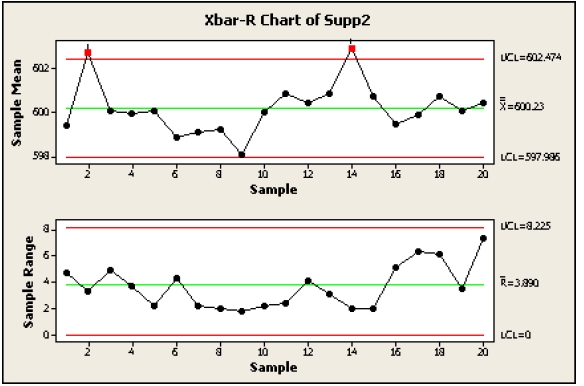

XbarR charts are useful when you have sub-groups. The D4 constant is a function of d2 and d3:.The constant takes into account the 3 used to calculate the upper and lower control limit. The constant 2.66 is sometimes used to calculate XmR chart limits.Calculate the upper and lower mR control limits.Data must be in the sequence the samples were produced. Find the center line by calculating the mean moving range of your data points.Calculate the upper and lower XmR control limits using the sequential deviation.

Xbar and r full#
For a full explanation see the following articles: XmR charts are the easiest control charts to make. There, I'll walk you though the math and simulation to pull it all together. To get a better grasp of what the bias correction factors are see my article on Estimating Control Chart Constants. Subsequent sections provide examples of how these constants are calculated. Bias Correction Control Chart Constantsīias correction constants are the fundamental quantities that allow you to calculate other higher level control constants such as A2, D3, D4, etc. To begin, we'll start with the building blocks – the bias correction factors. With that dispersion statistic in hand, we can calculate control limits for our data. In the next few sections, you'll see in brief how we change quantities such as mean moving range (mR), mean range, and mean standard deviation into a dispersion statistics using the control chart constants. XmR Chart | Step-by-Step Guide by Hand and with R.It's also nice to have a sense of what these numbers physically mean. Regardless of the available software, it's still good to have a place to find these numbers when you need them and quick explanation of their use. There are also commercially available options like minitab or JMP. Other opensource options include qcc, iqcc, and qicharts to name a few. Open source options include R's ggQC package.

Xbar and r software#
These days though, if you have a good piece of statistical software you wont even see these numbers. Why? Because, it's a nuisance to look up a constant to make a chart, and I suspect that has likely frightened away many would be users over the years. To me, control chart constants are a necessary evil. And, if you've made a control chart by hand or sat in a class, you'll likely have memories of bizarre constants like d2, A2, etc. Bias Correction Constants: d2, c4, d3, d4Ĭontrol chart constants are the engine behind charts such as XmR, XbarR, and XbarS.


 0 kommentar(er)
0 kommentar(er)
